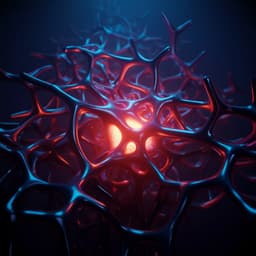
Engineering and Technology
Overcoming evanescent field decay using 3D-tapered nanocavities for on-chip targeted molecular analysis
S. Kumar, H. Park, et al.
Discover how a groundbreaking three-dimensionally-tapered gap plasmon nanocavity developed by Shailabh Kumar and colleagues at the California Institute of Technology overcomes limitations in fluorescence enhancement, achieving factors close to 2200 and enabling detection of low concentration biomarkers at single molecule resolution.
~3 min • Beginner • English
Introduction
The study addresses a central limitation in plasmonic fluorescence enhancement: the strong dependence of enhancement on the distance between fluorophores and plasmonic hotspots due to evanescent, exponentially decaying electromagnetic fields. In bioassays, fluorophores are attached to recognition elements (e.g., antibodies, aptamers), so emitter position varies with molecular size and assembly, causing large variability in enhancement and limiting assay accuracy and applicability. The authors propose that overcoming this requires (a) strong EM field confinement, (b) efficient emitter-field coupling to enhance radiative emission, and (c) a hotspot geometry that produces a uniform field distribution over a volume large enough for typical biomolecular complexes (~15 nm or more). They identify 3D-tapered metal–insulator–metal (MIM) gap plasmon waveguides as candidates for adiabatic nanofocusing of surface plasmon polaritons, but note prior designs were closed and inaccessible to molecules. They therefore design an open, fluidically accessible 3D-tapered gap plasmon nanocavity intended to generate a near-homogeneous, powerful volumetric hotspot at the tip, enabling consistent fluorescence enhancement across molecule sizes.
Literature Review
Prior work showed plasmonic nanostructures can strongly enhance fluorescence, enabling single-molecule sequencing, sensitive diagnostics, and dynamic biological studies, but enhancement strongly depends on emitter–metal distance, causing quenching near metal and variability with molecular size/position (Lakowicz 2005; Anger et al. 2006; Dragan et al. 2012; others). Various geometries (e.g., bowtie nanoantennas) provide high local fields but typically exhibit strong spatial decay and non-uniformity across the gap, leading to distance-dependent variability. MIM-based waveguides and tapered structures demonstrate efficient EM energy confinement and adiabatic nanofocusing (Pile & Gramotnev 2006; Choo et al. 2012), but previous closed, monolithic devices were not suitable for bioassays due to lack of fluidic access. The authors leverage this background to propose an open-access, 3D-tapered MIM nanocavity that integrates the strong nanofocusing capability with biofunctional interfaces for molecular capture, aiming to mitigate distance sensitivity and provide uniform enhancement across a volumetric hotspot.
Methodology
Device design and fabrication: Silicon wafers with 1 µm thermally grown SiO2 were coated with 50 nm Au by e-beam evaporation. Focused ion beam (FIB) milling (FEI Nova 600) patterned 3D-tapered nanocavities through Au and SiO2. A second 50 nm Au deposition and FIB milling removed Au from the cavity base to expose hydrophilic SiO2 and formed the tapered tip. Arrays with 20 nm-wide, 500 nm-long tips were fabricated.
Design optimization and simulations: Finite-difference time-domain (FDTD, Lumerical) used 1 nm uniform mesh. Excitation wavelength targeted 750 nm. Geometry: body width w_body = 150 nm, body length l_body = 150 nm, body height h_body = 3 µm; taper angle α = 20°. The structure supports an anti-symmetric (AS) SPP mode with electric field parallel to the SiO2 substrate between laterally separated Au walls. Simulations compared 3D-tapered, 2D-tapered (lateral taper only; body 150×50 nm²; same tip 20×50 nm²), tip-only MIM (no taper; 20×50 nm²), and a bowtie antenna (two 140 nm-side Au triangles, 50 nm thick, 20 nm gap, on 3 nm Cr/25 nm ITO). EM energy density u, total transversal EM energy U_λ, average |E|^2, hotspot uniformity (σ_E^2 from normalized E^2 over 20×50 nm²), and coupling efficiencies were computed. For coupling analyses, a 1.4-NA Gaussian source centered at 750 nm was focused at various longitudinal positions, measuring transmitted power. For fluorescence enhancement, a 750 nm dipole in the tip allowed computation of radiative and non-radiative decay rates and quantum yield gain; net enhancement = local field intensity enhancement × quantum yield gain.
Hotspot volume tuning: Tip length l_tip varied (∞, 500 nm, 20 nm) to tune longitudinal confinement and volumetric hotspot size; shorter l_tip increases |E|^2 within a smaller volume (e.g., 20×50×5 nm³ hotspot for l_tip = 20 nm with |E| magnitude ~550).
Biofunctionalization and assays:
- Surface biotinylation: Silane–PEG–biotin (SPB, MW 1000 or 5000) in 50% EtOH:water incubated 1 h on exposed SiO2; rinsed DI.
- Streptavidin binding: Streptavidin–Alexa Fluor 750 (SAF-750) in PBS (0.1 mg/mL) incubated 1 h, rinsed; concentrations varied for assays and diffusion detection (10 pM–1 nM for LOD tests; also 1 µM for dynamic capture visualization).
- Dye immobilization: APTES (1% in toluene) bound to SiO2 (30 min), baked (110 °C, 30 min), Alexa Fluor 750 NHS ester (1 mg/mL in DMSO) reacted 1 h; rinsed.
- Aptamer sensing: Adsorb insulin (10 µM in PBS) 1 h; block with 0.1% BSA; add insulin-binding aptamer (AF-750 at 5′, 1 µM in folding buffer: 10 mM Tris, 1 mM MgCl2·6H2O, 100 mM NaCl, pH 7.4) 1 h; wash and image.
- Antibody binding: Anti-biotin IgG1 (DyLight 755) at 0.05 mg/mL in PBS incubated 2 h; rinse. Tip-length controlled single or 1D array capture tested with l_tip = 20 nm (single antibody expected) and 500 nm (linear array).
- AFM: Tapping-mode AFM characterized monolayers on flat SiO2 to estimate packing and single-occupancy in 20×20 nm tips.
Imaging and analysis: Widefield fluorescence microscopy (Leica DMI 6000); SEM (FEI Nova 600/200). Fiji/ImageJ used for image analysis; data plotting in Matlab and GraphPad Prism. Illumination modes: tail-end and full-illumination; full-illumination used for quantitative assays based on superior coupling and collection (~9–10× stronger tip intensity).
Key Findings
- The 3D-tapered gap plasmon nanocavity adiabatically confines EM energy from the device body into a nanoscale open-access MIM tip, yielding near-homogeneous, powerful volumetric hotspots that mitigate evanescent-field decay.
- Simulations show efficient transversal confinement: total transversal EM energy in the body (U_λ_body) is confined into the tip with minimal loss (U_λ_body ≈ U_λ_tip), yielding high average energy density u_A at the tip. The 3D taper outperforms 2D-tapered and tip-only structures due to larger body cross-section storing more energy.
- Compared with a bowtie nanoantenna (20 nm gap), the optimized 3D taper achieved ~4× greater average energy density and ~40× improvement in hotspot uniformity. Quantitatively, the 3D-tapered tip exhibited ⟨|E|^2⟩ ≈ 230 with σ_E^2 = 0.05 and 11% net coupling efficiency.
- Hotspot tuning via tip length: l_tip = 20 nm produced |E| magnitude ≈ 550 within a ~20×50×5 nm³ volume; l_tip = 500 nm maintained a larger, uniform hotspot.
- Illumination: Full-illumination mode provided ~9× higher tip fluorescence intensity than tail-end illumination, matching FDTD (~10×), due to improved coupling and collection through the device body.
- Molecular detection: Specific capture and enhanced fluorescence observed for streptavidin–AF750 bound to biotinylated SiO2 inside tips; device enabled detection of proteins in solution down to 10 pM (diffusion-limited, potentially improved by active transport/trapping).
- Single-molecule capture: With l_tip = 20 nm and w_tip = 20 nm, geometry selectively trapped a single IgG antibody at the tip; measured fluorescence matched single-molecule expectation within 1.5% using simulated |E|^2 and integrated intensities. For l_tip = 500 nm, a 1D array of antibodies was formed.
- Fluorescence enhancement uniformity vs position: For l_tip = 500 nm, simulated net fluorescence enhancement (field × quantum yield gain) exceeded 1000 for ~70% of the channel width; FWHM covered ~95.5% of the x-axis, with quenching only very near metal sidewalls. Enhancement was highly uniform along the y-axis (height) across the 50 nm gap height, overcoming typical distance sensitivity.
- Quantum yield gain: The 3D-tapered cavity increased radiative decay rates, yielding up to 28.2% higher quantum yield gain along the channel width versus tip-only, enabling ~500× higher net fluorescence enhancement relative to the tip-only structure at positions compared.
- Experimental enhancement: For diverse molecular assemblies spanning fluorophore heights from <1 nm (surface dye) to ~20 nm (aptamers, streptavidin, antibodies), the device yielded uniform enhancement: l_tip = 500 nm gave EF ≈ 950; l_tip = 20 nm gave EF ≈ 2200. Enhancement figure of merit ≈ 260, among the highest reported, while uniquely maintaining independence from molecule size/height within the tip.
Discussion
The 3D-tapered, fluidically accessible MIM nanocavity addresses a key barrier in plasmon-enhanced fluorescence by creating a volumetric hotspot with high and uniform EM field intensity that minimizes dependence on emitter position and height. Adiabatic nanofocusing compresses EM energy from a larger body into the tip, suppressing typical evanescent decay and ensuring uniform enhancement across most of the tip cross-section and height. Enhanced radiative decay rates improve quantum yield, further boosting fluorescence compared with tip-only structures. Experimental assays confirm consistent, strong enhancement (up to ~2200) across molecular assemblies with heights spanning angstroms to ~20 nm, supporting the claim that enhancement is resistant to distance variations within the tip height and likely extends to assemblies up to ~50 nm (for this design). Practical capabilities include low-concentration biomarker detection (10 pM) and controlled capture of single antibodies or 1D arrays by tuning tip length, enabling high-resolution binding and functional analyses. These attributes broaden plasmonic fluorescence utility in bioassays, single-molecule studies, and potentially other nanophotonic applications requiring intense, uniform nanoscale fields.
Conclusion
This work introduces a 3D-tapered, open-access gap plasmon nanocavity that overcomes distance-dependent variability in plasmonic fluorescence by providing near-homogeneous, strongly confined volumetric hotspots with efficient emitter coupling. The device achieves experimentally verified fluorescence enhancement up to ~2200 (figure of merit ~260) uniformly across diverse molecular assemblies and enables both 10 pM protein detection and single-antibody capture via geometric tuning. The approach promises wider applicability of plasmon-enhanced fluorescence for sensitive biosensing and controlled single-molecule or small-array analyses. Future research should focus on scalable, low-roughness fabrication (e.g., nanoimprinting, e-beam lithography, template stripping, anisotropic etching) to improve throughput, reproducibility, and performance, and on adapting the design to other spectral regimes (mid-IR, THz) and nanophotonic functions (optical confinement, data transfer, quantum communication).
Limitations
Current fabrication relies on focused ion beam milling, limiting throughput and potentially increasing surface roughness; the device footprint is larger than some nanoscale antennas. These factors impact scalability and may limit ultimate performance. Improvements are anticipated by transitioning to wafer-scale, smoother-surface processes such as nanoimprint lithography, e-beam lithography, template stripping, and anisotropic etching for the tapered regions.
Related Publications
Explore these studies to deepen your understanding of the subject.







